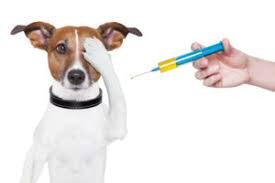What you need to know...
 What’s the point
of insurance? Why would anyone purchase something
with the intention of never using it? It sounds like a complete waste of money –
especially if the amounts involved are substantial! But we all know that
veterinary bills can be eye watering, so it's no wonder that about 40% of owners
have pet insurance. Policies can vary widely which means that it is very
important to get the right cover for your dog first time. Julia Carr explains
how it works and what to look for. What’s the point
of insurance? Why would anyone purchase something
with the intention of never using it? It sounds like a complete waste of money –
especially if the amounts involved are substantial! But we all know that
veterinary bills can be eye watering, so it's no wonder that about 40% of owners
have pet insurance. Policies can vary widely which means that it is very
important to get the right cover for your dog first time. Julia Carr explains
how it works and what to look for.
Most people are on the
whole, fairly optimistic. We need to be to have any potential of a normal life,
so we drive our cars, cross roads, fly on aeroplanes, move pans of boiling water
– in short, we do things that involve a degree of risk because we know that the
chances of anything awful happening to us are pretty slim. The concept of
insurance is therefore rather contrary to how we usually behave because it
forces us to consider that ‘what if’ possibility. Because we don’t really want
to think about using insurance, we buy it grudgingly, focussing on what it costs
rather than what we are gaining from it. A significant portion of the industry
is even marketed on the basis of saving customers money, rather than promoting
the benefits of the cover and with so many companies competing for business,
shopping around for the cheapest quote has never been easier.
The purpose of
insurance is not to protect ourselves or our belongings from harm, but to assist
if the worst should happen. In this respect its most notable benefit is
to provide peace of mind. Most policies provide cover for multiple risks and the
primary cover for pet insurance is almost always for veterinary fees, although
there are a few (dog only) polices which just cover liability. There are more
pet insurance policies available than ever and the choice can be daunting, as
well as the cost. On the surface it may be tempting to simply select a policy on
the basis of premium and the headline cover promises. However consumers should
always pay close attention to the dreaded ‘small print’ of any insurance policy
and this is especially true for pet insurance, because the devil really is in
the detail and making the wrong decision can have considerable long term
consequences.
 What is on offer? What is on offer?
Most
companies now offer lifetime cover, reflecting owner demand for longer term
insurance so it is much easier to get cover for chronic conditions. Check the
definition carefully! The veterinary fees limit may be per year, or per
condition and there is a substantial difference between the two. More rarely,
cover is offered per condition per year. Fixed duration cover may be renewed
annually but it will only cover the cost of treatment for any condition for one
year. There are also a few accident only policies which offer basic cover and
are considerably cheaper.
Many insurers have detailed explanations on their
websites which are worth reading, as choosing an appropriate type of policy is
the first decision to be made. In general, policies that cover ongoing
conditions with an annually refreshed allowance for vet fees are regarded as the
'top tier.'
No animal NHS
The
principle concern for most owners is to ensure that significant and unexpected
vet bills are covered. Advances in veterinary medicine have expanded the array
of treatment options, but the provision of specialist care can be expensive. It
is worth researching the costs of treating commonly occurring conditions and
injuries (such as arthritis and cruciate ligament surgery) to predict the level
of cover that might be required. The average maximum cover for vet fees is
currently about £6-7,000 with some policies covering up to £15,000.
It is extremely
important to read the policy booklet for this section as there are variations on
the types of treatment that different companies will cover. Routine treatment
(worming, insecticides, and dental work such as cleaning) is invariably
excluded, as is preventative neutering. Conventional treatment is always
covered, but most policies carry some restrictions or limits for complimentary
treatments (e.g. hydrotherapy).
Treatment which might be regarded as excessive
or unnecessary is frequently excluded. Home visits and even hospitalisation may
fall within this category if a justifiable medical reason cannot be given. Some
policies include cover for behaviour related referrals and behaviour treatment
products such as DAP collars and diffusers, but only if purchased on the advice
of a veterinary surgeon. Referrals to specialists are generally covered under
the normal limits for vet fees, but check the policy wording as some insurance
companies may preclude referrals unless the practice has been approved by the
company.
 Medical history Medical history
Almost
all pet insurance policies exclude cover for pre-existing medical conditions and
owners should check the definition of a pre-existing condition in the policy
booklet before deciding to purchase. Some policies could potentially exclude any
medical condition treated or observed during the entire course of the animal's
life. For instance treatment for a bout of sickness and diarrhoea in a puppy
could possibly result in an exclusion for claims for any gastro-intestinal
disorders later in life. Others define pre-existing medical conditions as
anything suffered within the previous 24 months, which seems more reasonable.
A
claim does not have to be made for a condition to be excluded and as a word of
caution, anything recorded on the pet’s veterinary record might be considered as
a pre-existing condition, even if no treatment has been given. It is important
to consider any previous veterinary treatment, however insignificant, when
taking a new policy or switching providers. For instance some policies will
exclude conditions that may reoccur in a different limb – e.g. cruciate ligament
injuries.
Not covered
Not all
insurance companies will cover Administration costs - so vet fees for filling
out a claim form might be excluded. It is also worth checking if claims are paid
directly to the vet or will the owner be required to pay the fees up front and
then claim the money back.
The policy EXCLUSIONS
are of critical importance and should always be read to ensure there are no
unpleasant surprises at claims stage. There will be general policy exclusions
and more specific exclusions that are relevant to each section of the cover. Pay
particular attention to the general exclusions as there may be restrictions for
dogs used for working, breeding guarding or racing and also those that accompany
their owners to work. If the definitions are not explicit, this could be
problematic so beware of ambiguous policy wording and if in doubt, CHECK with
the insurer before making a commitment to buy.
 Owner contributions Owner contributions
Eexcesses are well worth paying attention to. Fixed excesses mean that a set
amount is deducted from the settlement of the claim but many insurers also ask
for a percentage contribution instead of or on top of the excess, especially
once the pet reaches a certain age. (The policy wording will state whether this
is calculated prior to or after any fixed excess is deducted.) A 20%
contribution on a £1000 claim is £200. Some insurers allow customers to select
an excess which best meets their needs. A higher excess contribution will reduce
the premium but the money must be available if required.
Customer Experience
Reviews are worth
reading, but take these with a pinch of salt. People are far more likely to post
a bad review to vent their feelings, so ratings and scores alone only tell a
partial story. In many cases, dissatisfaction is down to unrealistic
expectations or a failure to check the policy cover. Reviews discussing Renewal
Premiums where no claims/changes have been made are most useful, as they can
give an indication into likely premium increases. Pet insurers are well aware
that owners are often reluctant to change companies, especially following a
claim for a potentially reoccurring condition. Premiums which are initially low
can rise dramatically over subsequent years leaving owners tied to policies that
they might struggle to afford.
Conditions of cover
Vet
checks and vaccination: Some insurance policies appear very enticing with
reasonable premiums, good cover and fair excesses but the policy wording may
reveal some pitfalls. For instance, a claim may be declined if the pet has not
had an annual check-up (presumably for any condition that MIGHT be picked up
during a routine examination - e.g. arthritis, heart disease etc.) Insurance
companies understandably won’t pay claims for diseases preventable by
vaccination if the dog isn't vaccinated - but check the policy definition as
some insist upon annual vaccination while others require compliance with
recommended intervals.
 Beneath the surface Beneath the surface
Make a
point of checking the policy underwriter. It is often possible to identify
similarities between policies and this is frequently because they share an
underwriter, even though the cover may be quite different. It is useful to do
some research into the underwriter’s reputation, particularly with reference to
pet insurance (underwriters generally cover multiple types of insurance
products).
Comparison websites
are popular and useful but not all companies use them and many insurers do not
appear on all websites. They are a good starting point but always visit the
insurer’s own website and check for any variations - some excesses and covers
are not included in the initial quote and there may be different policies on
offer.
Waiting time
Finally
it is worth noting the initial exclusion period, especially when changing
policies. This can vary so beware. Illnesses are usually excluded for the first
fourteen days of cover but accidents may be covered sooner, sometimes within as
little as 48 hours of taking out the policy. Unlike car insurance, pet insurance
policies can legally be overlapped so there is no break in cover. As always,
check with the insurance companies for any terms and conditions that may be
relevant if two covers are briefly in force together.
The Policy Booklet
In
summary, when choosing a pet insurance policy it is absolutely vital to read
the policy booklet itself, not just the selling points on the website or even the
key facts. If anything isn't clear, check with the company before committing and
ensure that the answer is sufficiently explicit to remove any potential doubt.
Many companies offer enticing ‘gifts’ to new policy holders but these can really
be disregarded as a deciding factor unless two policies are equal in all other
respects. Specialist pet insurers may appear to be the obvious choice over
policies provided by supermarkets and chain stores but surprisingly this is not
necessarily true as the non-specialist policies can contain fewer conditions and
exclusions. It is often helpful to make a list of ‘needs’ and compare policies
against each other in a tick/cross fashion to ensure all the priority criteria
are covered.
 Choose wisely! Choose wisely!
Look
upon pet insurance as a long term contract rather than anticipating switching
providers annually and consider what it offers relative to the lifestyle of the
pet and the owner’s circumstances. A few specialist pet insurers offer free
limited duration cover for puppies and some rehoming organisations will also
provide similar policies for newly adopted dogs. While it is tempting simply to
continue insuring with these providers, new owners should still take the time to
research other policies before making a commitment.
As a general rule,
premiums will reflect the cover levels. Insurance companies all have similar
overhead costs and providers offering budget prices will be logically be making
savings somewhere along the line. However the most expensive policies may not be
the most appropriate either and owners should chose cover that best meets their
needs while remaining affordable. The 'ultimate' pet insurance policy simply
doesn’t exist - all have pros and cons so a degree of pragmatism is essential.
The more research that
is done the better as this is the only way to make an informed choice and
remember that one size most definitely does not fit all.
 About the author... About the author...
Julia Carr
has worked in the
insurance industry for over ten years and holds and FPC Level 1 qualification.
She has been competing
in agility since 2014 and runs two shelties currently in Grades 5 and 6.
First published 2 October 2017
|